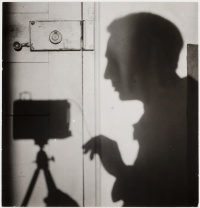André Kertész
André Kertész (2 July 1894 – 28 September 1985), born Kertész Andor, was a Hungarian-born photographer known for his groundbreaking contributions to photographic composition and the photo essay. Today he is considered one of the imprtant figures of photojournalism.
Life and work
André Kertész (1894–1985) was one of the most important photographers of the twentieth century. Working intuitively, he captured the poetry of modern urban life with its quiet, often overlooked incidents and odd, occasionally comic or even bizarre juxtapositions. He endeavored “to give meaning to everything” around him with his camera. Combining this seemingly artless spontaneity with a sophisticated understanding of composition, Kertész created a photographic idiom that celebrates direct observation of the everyday.
Born Kertész Andor in Budapest, he received his first camera in 1912 and immediately began to make intimate portraits of family and friends, and landscape studies of the Hungarian countryside. Seeking to make a living through photography, he moved to Paris in 1925, where he established a successful career as a photojournalist. Buoyed by this accomplishment and inspired by the vibrant artistic community of the French capital, he created some of the most intriguing and celebrated images of the period. Like other newcomers to Paris, Kertész wandered the streets alone for hours, discovering the visual poetry of the city. Photographs of almost-empty benches in the Luxembourg Gardens speak of Kertész’s initial loneliness, but also of his rapture at the urban beauty around him. He began to gain recognition as a photographer who poetically captured traditional Parisian life and culture through his images of cafés, fairs, parks, streets, and bridges.
In 1936, Kertész relocated to New York to further his career. Lured by the prospect of financial security, he agreed to work as a fashion photographer but almost immediately realized he was ill-suited for such work. He eventually accepted a contract photographing architecture and interiors for House and Garden, but he found this commercial work uninspiring. By the 1950s and early ‘60s, Kertész again began to photograph those spaces of quiet contemplation—rooftops, parks, benches—that offered a haven from the bustling pace of urban life. Photographing for over half a century in Hungary, Paris, and New York, he created some of the most deceptively simple yet poetically compelling pictures ever made [1].
